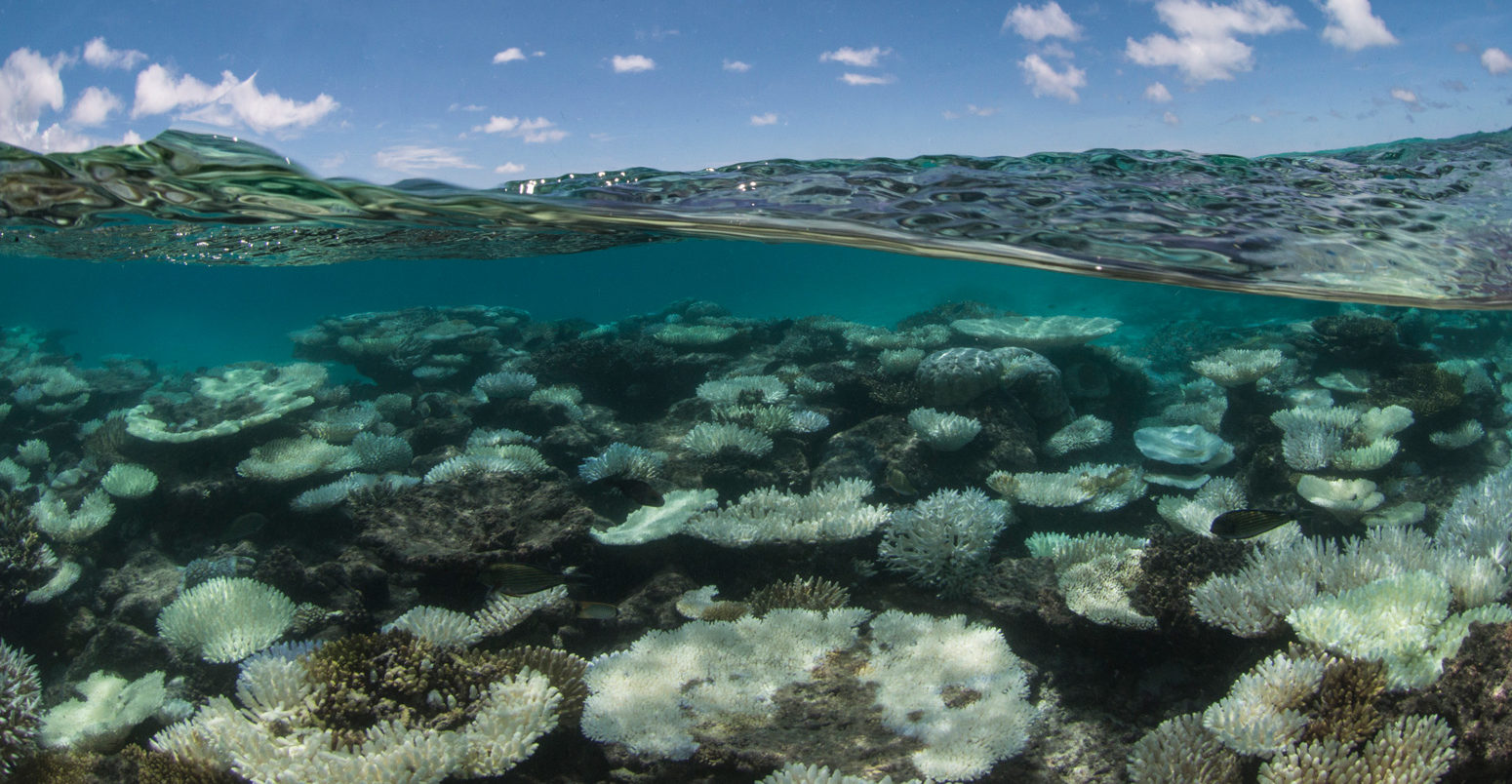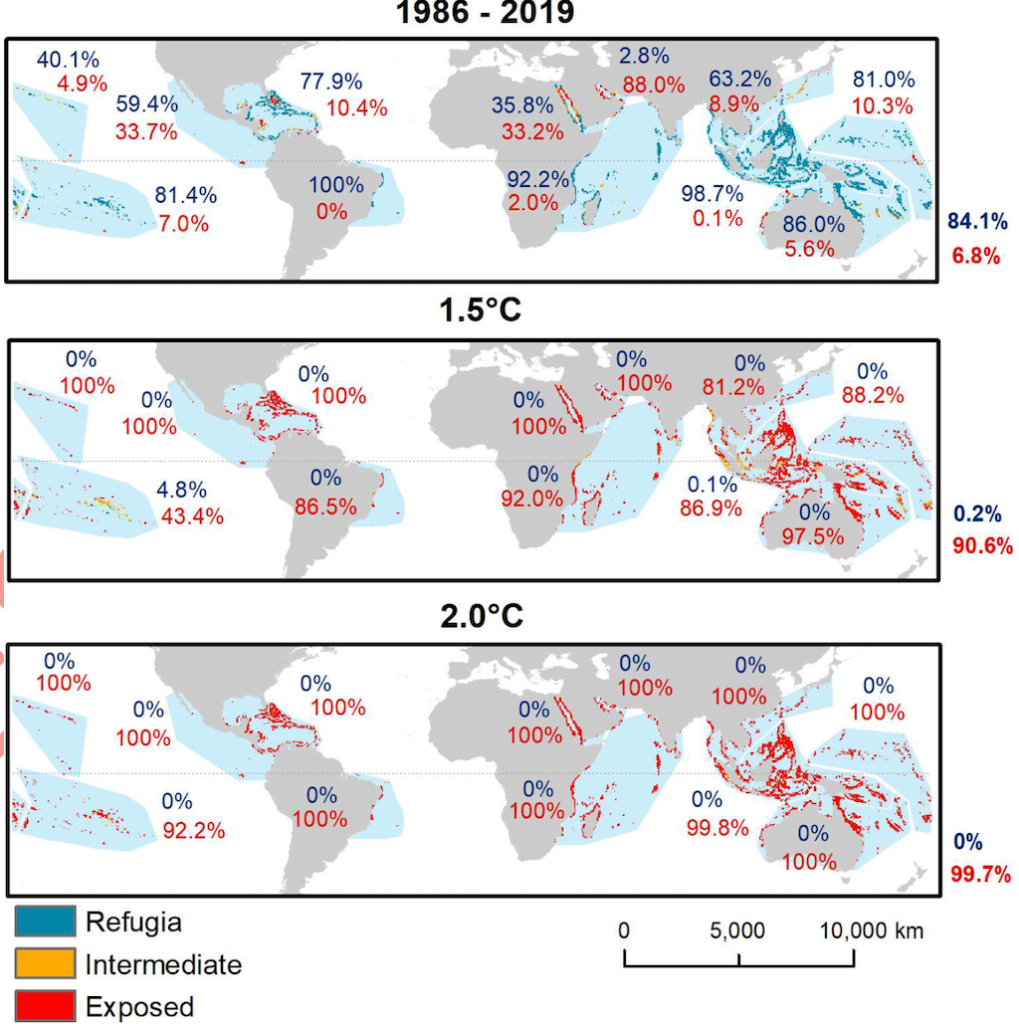
Last refuges for coral reefs to disappear above 1.5C of global warming, study finds
Daisy Dunne
02.01.22Daisy Dunne
01.02.2022 | 7:00pmLast refuges for the world’s ailing coral reefs could vanish completely if global warming exceeds 1.5C above pre-industrial levels, a study finds.
Across the world, coral reefs and the wildlife that depends on them face a severe threat from marine heatwaves, which have become 34% more likely over the past century.
At present, 84% of coral reefs are located in regions where conditions allow them to withstand the impact of marine heatwaves, the research says.
However, at 1.5C of global warming, this figure is projected to drop to just 0.2%. And at 2C of global warming, the study projects that all last refuges for coral reefs will cease to exist.
The findings “confirm” that even 1.5C of warming “will be catastrophic for coral reefs”, the study authors say.
To improve the prospects facing coral reefs, “the world needs to urgently address the root cause of the problem – pollution from greenhouse gases”, a scientist tells Carbon Brief.
Cooked
Coral reefs support a quarter of all marine life, including more than 4,000 species of fish. They also provide a source of income or food to half a billion people.
A landmark report by the Intergovernmental Panel on Climate Change (IPCC) published in 2018 identified tropical coral reefs as one of the most climate-vulnerable ecosystems on Earth.
One way that climate change threatens coral reefs is by driving an increase in the frequency and severity of marine heatwaves.
During prolonged periods of heat, reefs can experience mass coral bleaching. This occurs when coral releases the colourful algae that lives inside its tissue, leaving it a ghostly white. The algae acts as the primary source of food and, without it, coral slowly starves.
Coral reefs typically take at least 10 years to recover from episodes of mass bleaching, research suggests.
The new study, published in the recently launched journal PLOS Climate, examines where on Earth coral reefs are likely to have enough time to recover from bleaching events. That is, where marine heatwaves currently take place every 10 years or more.
The authors call these sites “thermal refugia”, noting that they “have been suggested as ‘slow lanes’ which may allow time for genetic adaptation to warmer conditions”.
The results show that, at present, 84% of reefs are located in regions where marine heatwaves are likely to occur every 10 years or more.
However, at 1.5C of global warming, this drops to 0.2%, says study lead author Adele Dixon, a PhD researcher at the Priestley International Centre for Climate at the University of Leeds. She tells Carbon Brief:
“There is no safe warming limit for coral reefs – action on climate change causes this decade is critical.”
Hotspots
For the research, the researchers combined satellite data showing global sea temperatures with climate model projections.
“We increased the resolution of climate model projections in a process called ‘downscaling’,” Dixon says, “which is important because thermal stress can vary between reefs that are located close together.”
The researchers examined coral heat stress in the present day (using the period 1986-2019) and under two future scenarios. These scenarios include where global temperatures reach 1.5C and 2C.
(Under the Paris Agreement, countries agreed to keep temperatures below 2C, with an aspiration of limiting warming to 1.5C. Today, temperatures are already around 1.1C above pre-industrial levels. Current pledges and long-term targets put forward by countries would, if met, see the world warm by 2.1C by the end of the century, according to the research group Climate Action Tracker.)
The map below shows where coral reefs are likely to be able to recover from marine heatwaves (“refugia”, dark blue shading) under present conditions (top), 1.5C of warming (middle) and 2C of warming (bottom).
It also includes the location of “exposed” reefs (red), which are likely to see marine heatwaves every five years or less, and “intermediate” reefs (orange), which are likely to experience heat every five to 10 years. Dixon explains:
“This might not be enough time for many species to recover but some fast-growing species may be able to survive this frequency of heat stress.”
On the map, the proportion of “refugia” and “exposed” reefs is given for different world regions.

The study projects that, at 1.5C, coral reefs will be able to survive marine heatwaves in only two locations: Polynesia and the Coral Triangle, a marine area in the Pacific Ocean including the waters of Indonesia, Malaysia, the Philippines, Papua New Guinea, Timor Leste and the Solomon Islands.
The reason why most corals will not be able to withstand even small additional increases in global temperature is that many are already living close to their thermal limits, says Dixon:
“Reef-building corals are already living in the upper limit of their preferred temperature range, which varies for corals in different locations around the world (typically, about 18-30C in the tropics and 14-36C in areas with more seasonal variability like the Persian Gulf). So, small increases in temperature quickly exceed this upper limit.”
‘Nowhere to hide’
The findings reinforce the case for slashing global emissions as fast as possible, says Dixon:
“There are many attempts to conserve coral reefs: protecting biodiversity, restoration efforts, reducing other stressors, and research into creating and outplanting more thermally tolerant coral individuals. While all these efforts, undertaken together, help reef ecosystems on local levels, our results show that only global emissions reduction and carbon sequestration can prevent large-scale reef loss.”
The study confirms that “there is nowhere to hide from global warming”, says Prof Terry Hughes, a veteran coral reef scientist and distinguished professor at James Cook University in Queensland, Australia, who was not involved in the study. He tells Carbon Brief:
“Fewer and fewer coral reefs will remain untouched by recurrent bleaching in the near future. Even now, that pattern is clear: The first pan-tropical bleaching event was recorded in 1998, then the hottest year on record. Since then, almost all coral reefs have already experienced multiple episodes of mass coral bleaching, caused by rising sea temperatures.”
He adds that Australia’s Great Barrier Reef (GBR), which is reportedly on the verge of another mass coral bleaching event, has already seen a decline in possible refuges for corals:
“Places that we once thought might be enduring refuges from rising temperatures have rapidly dwindled in number and size. After the three latest heatwaves in 2016, 2017 and 2020, only 1.7% of the individual reefs comprising the entire GBR remain unbleached today. The GBR is a checkerboard of reefs that are damaged by different levels of bleaching, and in different stages of recovering – until recovery is interrupted by the next heatwave.”
He agrees that the findings further bolster the case for tackling the root cause of climate change:
“Instead of relying on a dwindling number of refuges to rescue depleted reefs elsewhere, the world needs to urgently address the root cause of the problem – pollution from greenhouse gases.”
Dixon et al. (2022) Future loss of local-scale thermal refugia in coral reef ecosystems, PLOS Climate, https://journals.plos.org/climate/article?id=10.1371/journal.pclm.0000004
-
Last refuges for coral reefs to disappear above 1.5C of global warming, study finds

